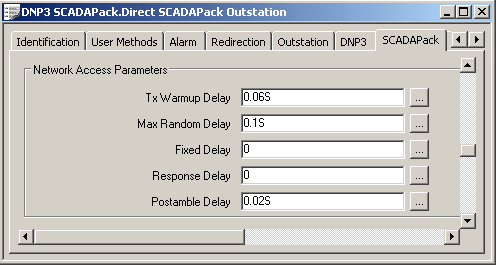For multi-drop networks, the SCADAPack E outstation can perform ‘media collision avoidance’, whereby transmissions are checked for collisions with another transmission on the network. If a collision is detected, the outstation re-attempts the transmission, after a delay. The Modes that support collision avoidance are:
- RS232 (RTS Keyed)
- FSK Radio (only available on Port 3 on 386 eNET outstations)
- FSK Landline (only available on Port 3 on 386 eNET outstations).
Use the fields within the Network Access Parameters section of the SCADAPack tab to define the operational characteristics when a SCADAPack E outstation uses a multi-dropped network, such as a radio network. Specify each value in the OPC Time Format.

- Tx Warmup Delay—Specify the delay that is required between the transmission media being activated and the actual transmission of data. This delay allows the transmission device (for example, a radio unit) to activate its transmitter.
- Max Random Delay—Specify the maximum additional delay that the outstation adds to the Fixed Delay, before sending data on the transmission media, once the outstation has detected a transmission collision. The outstation will add a random delay of any length up to and including this value.
- Fixed Delay—Specify the fixed time delay for which the outstation waits, before attempting a data transmission, once it has detected a transmission collision. Before the transmission is attempted, the outstation adds an additional random delay (see Max Random Delay above).
If both the Fixed Delay and Max Random Delay are set to zero, the SCADAPack E outstation does not perform any collision avoidance.
- Response Delay—Specify the period for which the outstation is to delay transmission of any data prior to activating the transmission device. A delay other than zero may be required where a radio repeater is slow to drop its carrier and the outstation tries to respond too quickly to a request to send data.
- Postamble Delay—Specify the amount of time that has to elapse between the last byte being sent and the Request to Sent (RTS) signal being turned off.